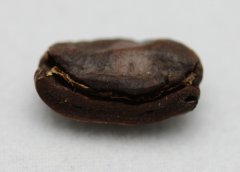Coffee beans, coffee, where do you get male and female coffee?
Chicken has cock hen cent, egg can have male egg female egg cent?
A friend who had just returned from Bali, Indonesia, told me that she had been to Bali and had been recommended male beans by the locals and had taken a cup test on the spot. The male beans tasted significantly better than the female beans. The bar supervisor of a five-star hotel boasted to me that all the beans supplied by their suppliers were male beans and none of them were female beans. Good coffee beans, how does this male and female say come from?
The male and female coffee beans originated in Indonesia, spread in Taiwan, and ended in the mainland. Its influence is mainly concentrated in the above three places, so the locals in Bali will sell coffee with male beans as selling points.
The so-called male beans refer to the special fruit that only produces one coffee bean in a coffee fruit, because its shape is generally shuttle type, in order to be different from ordinary flat coffee beans, so called round beans (Peaberry), that is, the so-called male beans, other normal beans are called female beans. Botanically speaking, monoecious coffee is not divided into male and female, so the male and female are just a term invented by businessmen.
The proportion of male beans in coffee beans is generally 5%~8%, according to statistics, most of the male beans are growing in the outer part of the tree crown is more susceptible to external factors interference, so there is also a saying that the male beans are actually due to some kind of external force under the action of the product.
In terms of taste, male beans do have a richer fat, a fuller taste and a mellower aftertaste, which is why people will go after male beans. However, scientists have no evidence that male beans have more soluble aromatic substances than female beans, just that they are richer in oil, which is also caused by the fact that one male bean takes up two female beans.
Important Notice :
前街咖啡 FrontStreet Coffee has moved to new addredd:
FrontStreet Coffee Address: 315,Donghua East Road,GuangZhou
Tel:020 38364473
- Prev

Coffee beans Brazil coffee taste supple world coffee production champion
The cultivation of Brazilian coffee began more than 280 years ago in 1727. Legend has it that the handsome army officer Pacita was sent to French Gaiana to mediate the territorial dispute between France and the Netherlands. The wife of French Gaiana actually fell in love with him and gave him a bag of bourbon coffee seeds. Right after Parcia returned to Brazil, Para changed his career as a coffee farmer and began to grow coffee.
- Next

Look, hear, ask and buy high quality coffee beans
Cut, is through pinching, cutting, chewing and other methods to quickly determine the general taste, freshness and baking uniformity of coffee beans. Through this step and the combination of watching and smelling, we can accurately judge whether the coffee beans have just been baked, and the roasting level of the coffee beans will be at a glance. Here are a few techniques one by one. To pinch is to grab a few coffee beans
Related
- Guji coffee producing area of Guji, Ethiopia: Humbela, Shakiso, Wulaga
- What is the most expensive variety of Qiloso in BOP multi-variety group?
- How to store the coffee beans bought home?
- Why are Yemeni coffee beans so rare now?
- Ethiopian Sidamo all Red Fruit Sun Sun Santa Vini Coffee beans
- SOE is mostly sour? What does it mean? Is it a single bean? what's the difference between it and Italian blending?
- Is Italian coffee beans suitable for making hand-brewed coffee?
- How to choose coffee beans when making cold coffee? What kind of coffee beans are suitable for making cold coffee?
- Just entered the pit to make coffee, what kind of coffee beans should be chosen?
- Can only Japan buy real Blue Mountain Coffee? What are authentic Jamaican Blue Mountain coffee beans?

